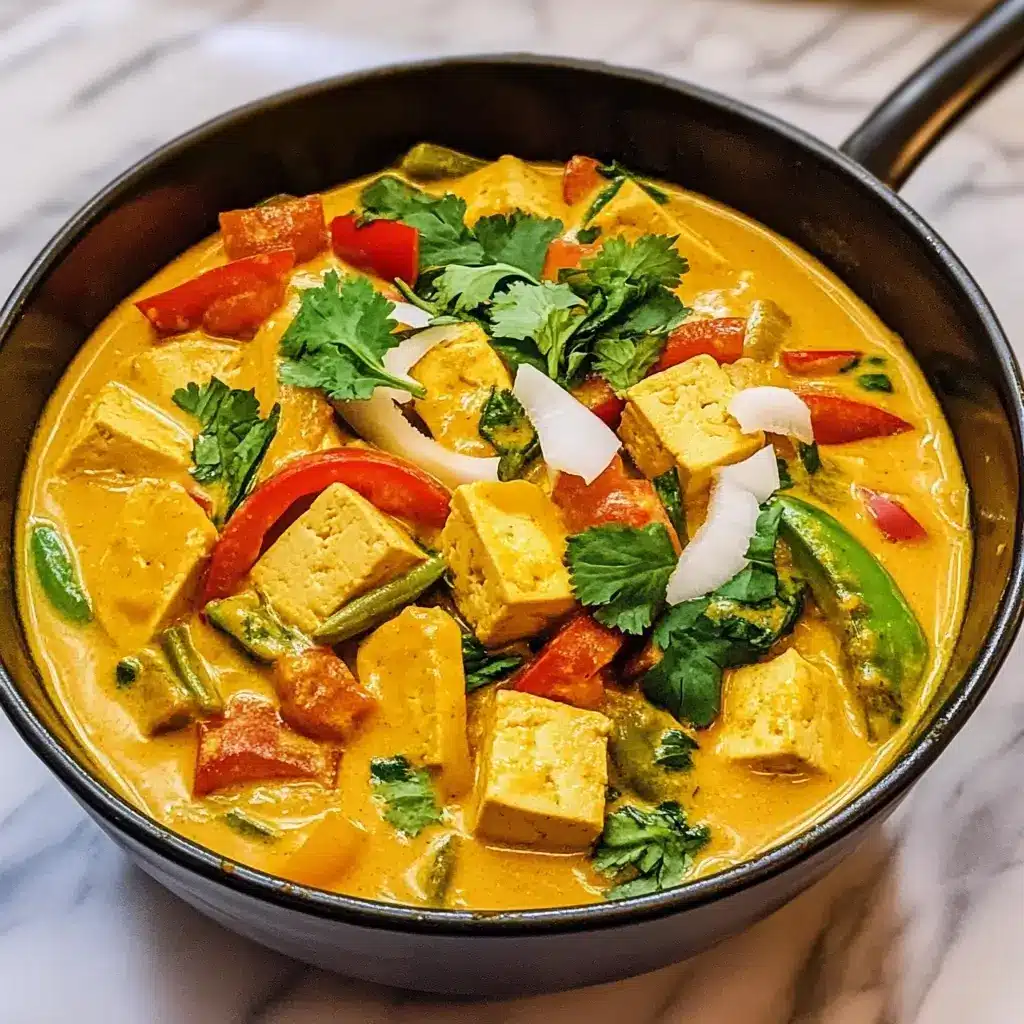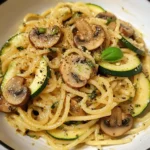This Tofu Coconut Curry Bowl has become an absolute staple in our household. The first time I made it, I was cautiously optimistic – my family can be a mixed bag with tofu. But the moment the fragrant aroma of coconut, ginger, garlic, and spices began to fill the kitchen, I knew I was onto a winner. The kids, initially skeptical of the “white blocks,” were soon asking for seconds, mesmerized by the creamy sauce and the tender, flavor-infused tofu. My partner, a lover of all things spicy and comforting, declared it one of the best curries he’s had, homemade or otherwise. It’s that perfect balance of creamy, savory, slightly sweet, and as spicy as you dare to make it. It’s become our go-to for a quick weeknight meal that feels indulgent, a comforting bowl on a chilly evening, and even a dish I’m proud to serve to guests. The vibrant colors of the vegetables against the rich, golden curry sauce are a feast for the eyes before it even hits your palate. It’s not just a meal; it’s an experience – one that’s surprisingly easy to create.
Ingredients
- 1 (14-16 ounce) block extra-firm tofu, pressed and cubed: The star protein, pressed to remove excess water for better texture and flavor absorption.
- 1 tablespoon coconut oil or vegetable oil: For sautéing and preventing sticking.
- 1 medium yellow onion, chopped: Forms the aromatic base of the curry.
- 2-3 cloves garlic, minced: Adds pungent depth and aroma.
- 1-inch piece fresh ginger, grated or minced: Provides a warm, zesty kick.
- 1 red bell pepper, sliced: Adds sweetness, color, and a slight crunch.
- 1 green bell pepper, sliced (optional, for color variation): Complements the red pepper with a slightly more savory note.
- 1 cup broccoli florets: Adds a nutritious green element and a pleasant texture.
- 1/2 cup snap peas or snow peas (optional): For a crisp, fresh bite.
- 2-4 tablespoons red curry paste (adjust to your spice preference): The heart of the curry flavor, providing spice, aromatics, and complexity. Choose a good quality brand.
- 1 (13.5-ounce) can full-fat coconut milk: Creates the rich, creamy sauce. Full-fat is essential for the best texture and flavor.
- 1/2 cup vegetable broth or water: Helps to thin the sauce to the desired consistency.
- 1 tablespoon soy sauce or tamari (for gluten-free): Adds umami and depth of flavor.
- 1-2 teaspoons maple syrup or brown sugar (optional, to balance flavors): Enhances sweetness and balances the spice and acidity.
- 1 tablespoon lime juice, freshly squeezed: Brightens the flavors and adds a touch of acidity.
- 1/2 cup fresh spinach or kale, roughly chopped (optional): Wilts into the curry, adding extra nutrients and color.
- Fresh cilantro or Thai basil, chopped, for garnish: Adds a final burst of freshness.
- Cooked rice (basmati, jasmine, or brown) or quinoa, for serving: The perfect vessel to soak up the delicious curry sauce.
Instructions
- Prepare the Tofu:
- If you haven’t already, press the tofu for at least 30 minutes to remove excess water. You can use a tofu press or wrap the block in paper towels or a clean kitchen towel and place something heavy on top (like a few cookbooks).
- Once pressed, cut the tofu into 1-inch cubes.
- In a large skillet or wok, heat 1 tablespoon of coconut oil over medium-high heat.
- Add the tofu cubes in a single layer (work in batches if necessary to avoid overcrowding).
- Pan-fry the tofu for 5-7 minutes per side, or until golden brown and slightly crispy on all edges.
- Remove the tofu from the skillet and set aside on a paper towel-lined plate. This step is crucial for achieving a pleasant texture; unbrowned tofu can be a bit bland in curries.
- Sauté the Aromatics:
- To the same skillet (add a touch more oil if needed), reduce the heat to medium.
- Add the chopped yellow onion and sauté for 5-7 minutes, until softened and translucent. Stir occasionally to prevent burning.
- Add the minced garlic and grated ginger to the skillet. Sauté for another 1-2 minutes until fragrant. Be careful not to burn the garlic, as it can become bitter.
- Build the Curry Base:
- Add the red curry paste to the skillet with the onions, garlic, and ginger.
- Cook for 1-2 minutes, stirring constantly, until the curry paste is fragrant and slightly darkened. This step, often called “blooming” the spices, is vital for releasing the full flavor potential of the paste.
- Add Vegetables and Simmer:
- Add the sliced red bell pepper (and green, if using) and broccoli florets to the skillet. Stir to coat them with the curry paste mixture. Cook for 3-5 minutes, allowing the vegetables to soften slightly but still retain some crispness.
- Pour in the full-fat coconut milk and vegetable broth (or water). Stir well to combine, ensuring any bits of curry paste stuck to the bottom of the pan are incorporated into the sauce.
- Bring the mixture to a gentle simmer.
- Season and Thicken:
- Once simmering, stir in the soy sauce (or tamari) and maple syrup (or brown sugar, if using). Taste the sauce and adjust seasonings as needed. You might want more curry paste for heat, more soy sauce for saltiness, or more sweetener to balance.
- Reduce the heat to low, cover the skillet, and let the curry simmer for 10-15 minutes. This allows the flavors to meld together and the vegetables to cook through to your desired tenderness. The sauce will also thicken slightly during this time.
- Incorporate Remaining Ingredients:
- If using snap peas or snow peas, add them to the curry during the last 5 minutes of simmering, so they retain their crispness.
- Gently stir the pan-fried tofu cubes back into the curry. Allow them to heat through for a couple of minutes, soaking up the flavorful sauce.
- If using spinach or kale, add it now. Stir until the greens are just wilted into the sauce, which should only take a minute or two.
- Finish and Serve:
- Remove the skillet from the heat.
- Stir in the freshly squeezed lime juice. This final touch brightens all the flavors and adds a refreshing zing.
- Taste one last time and make any final adjustments to seasoning if necessary.
- Serve the Tofu Coconut Curry hot over cooked rice (basmati, jasmine, or brown) or quinoa.
- Garnish generously with fresh chopped cilantro or Thai basil. Optional additions like a sprinkle of red pepper flakes, toasted sesame seeds, or a lime wedge on the side also enhance the dish.
Nutrition Facts
- Servings: 4
- Calories per serving: Approximately 450-550 kcal (This can vary based on the exact brand of coconut milk, amount of oil used, and specific vegetables).
- Protein: Approximately 18-22g. Tofu is an excellent source of complete plant-based protein, essential for muscle repair and growth.
- Healthy Fats: Approximately 30-38g. Primarily from coconut milk and oil, providing energy and aiding in the absorption of fat-soluble vitamins.
- Fiber: Approximately 6-9g. From vegetables and tofu, promoting digestive health and satiety.
- Carbohydrates: Approximately 25-35g. Mainly from vegetables and any added sweetener, providing energy. (Note: Rice/quinoa served with it will add more carbohydrates).
- Vitamin C: Significant amounts from bell peppers and broccoli, an important antioxidant that supports the immune system.
Preparation Time
- Prep Time: 20-25 minutes (includes pressing tofu if not done ahead, chopping vegetables, and measuring ingredients).
- Cook Time: 30-35 minutes (includes pan-frying tofu and simmering the curry).
- Total Time: Approximately 50-60 minutes. This makes it a feasible and incredibly rewarding meal for a weeknight, yet special enough for a weekend treat.
How to Serve
Serving this Tofu Coconut Curry Bowl is all about creating a satisfying and aromatic experience. Here are some ideas:
- Base Choices:
- Steamed Rice: The classic choice.
- Basmati Rice: Long-grain, aromatic, and fluffy.
- Jasmine Rice: Slightly sticky and fragrant, perfect for soaking up the sauce.
- Brown Rice: A healthier, whole-grain option with a nuttier flavor and chewier texture.
- Quinoa: A protein-packed, gluten-free alternative that adds a lovely texture.
- Cauliflower Rice: For a low-carb, grain-free option.
- Rice Noodles: Thin rice vermicelli or thicker pad Thai style noodles can turn this into a delicious noodle bowl.
- Steamed Rice: The classic choice.
- Garnishes (Don’t skip these! They elevate the dish):
- Fresh Herbs:
- Chopped Cilantro: Adds a bright, citrusy freshness.
- Thai Basil: Offers a slightly spicy, anise-like flavor that complements curry beautifully.
- Fresh Mint: A surprising but delightful addition for a cooling contrast.
- Citrus:
- Lime Wedges: A squeeze of fresh lime juice right before eating brightens all the flavors.
- Crunch and Spice:
- Toasted Sesame Seeds (black or white): Add a nutty crunch.
- Toasted Peanuts or Cashews, roughly chopped: For extra texture and richness.
- Red Pepper Flakes or thinly sliced fresh chili (like bird’s eye): For those who like an extra kick of heat.
- Crispy Fried Onions or Shallots: A delightful textural contrast.
- Creaminess (Optional):
- A swirl of coconut cream or a dollop of plain vegan yogurt: For added richness or a cooling element.
- Fresh Herbs:
- Presentation:
- Serve in individual deep bowls to comfortably hold the curry and its base.
- Spoon a generous portion of the chosen base (rice, quinoa) into each bowl.
- Ladle the Tofu Coconut Curry generously over the base, ensuring a good distribution of tofu, vegetables, and sauce.
- Artfully arrange your chosen garnishes on top. A sprinkle of cilantro, a lime wedge on the side, and a scattering of sesame seeds can make the dish look restaurant-quality.
- Consider serving with a side of naan bread or roti for dipping into the delicious sauce.
Additional Tips
- Perfectly Pressed Tofu: Don’t skip pressing the tofu! The more water you remove, the firmer the tofu will be, and the better it will absorb the curry flavors and crisp up when pan-fried. For an even chewier texture, you can freeze the tofu block (in its original packaging), thaw it, and then press it.
- Customize Your Veggies: This curry is incredibly versatile. Feel free to swap or add vegetables based on what you have on hand or prefer. Other great options include carrots (sliced or diced), mushrooms (cremini or shiitake), zucchini, sweet potatoes (cubed and pre-cooked slightly), or green beans. Adjust cooking times accordingly.
- Control the Spice Level: Red curry paste varies in spiciness by brand. Start with a smaller amount (e.g., 2 tablespoons) if you’re sensitive to heat, and you can always add more later. For extra heat, add a pinch of cayenne pepper, a finely chopped fresh chili (like serrano or bird’s eye) with the aromatics, or serve with sriracha or chili oil on the side.
- Achieve Crispier Tofu (Alternative Methods): For even crispier tofu, after pressing and cubing, toss it with a tablespoon of cornstarch before pan-frying. Alternatively, you can bake the tofu cubes (tossed with a little oil) at 400°F (200°C) for 20-25 minutes, flipping halfway, or use an air fryer until golden and crisp.
- Coconut Milk Choice: Always use full-fat canned coconut milk for the best flavor and creamiest texture. Light coconut milk will result in a thinner, less rich curry. Shake the can well before opening, as the cream and water can separate.
- Flavor Boosters: For an even deeper flavor profile, consider adding a teaspoon of turmeric powder along with the curry paste for color and earthy notes, or a splash of fish sauce (if not strictly vegan/vegetarian) for added umami – though soy sauce/tamari does a great job for a plant-based version. A stalk of lemongrass (bruised and added during simmering, then removed) can also impart a lovely citrusy aroma.
- Make-Ahead & Storage: This curry tastes even better the next day as the flavors meld. Store leftovers in an airtight container in the refrigerator for up to 3-4 days. Reheat gently on the stovetop or in the microwave. If the sauce thickens too much upon refrigeration, add a splash of water or vegetable broth when reheating.
- Don’t Overcook Vegetables: Aim for tender-crisp vegetables rather than mushy ones. Add quicker-cooking vegetables like snap peas or spinach towards the very end of the cooking process to maintain their texture and vibrant color.
FAQ Section
- Q: Can I use a different type of tofu?
A: Extra-firm tofu is highly recommended for its ability to hold its shape and achieve a good texture. Firm tofu can also work, but it might be slightly more delicate. Silken or soft tofu is not suitable for this recipe as it will fall apart. - Q: Is this Tofu Coconut Curry Bowl vegan and gluten-free?
A: Yes, as written (using tamari instead of soy sauce for gluten-free), this recipe is fully vegan and can easily be gluten-free. Ensure your red curry paste is also vegan (most are, but some can contain shrimp paste) and gluten-free if that’s a concern. - Q: What if I don’t have red curry paste? Can I use green or yellow?
A: Yes, you can substitute with green or yellow curry paste. Green curry paste is typically spicier and has a more herbaceous flavor. Yellow curry paste is generally milder and has more turmeric and sweeter spices. The flavor profile will change, but it will still be delicious! Adjust the amount based on the spice level of the paste you choose. - Q: My curry isn’t thick enough. How can I thicken it?
A: If your curry is too thin, you can create a slurry by mixing 1 tablespoon of cornstarch with 2 tablespoons of cold water. Stir this into the simmering curry and cook for a minute or two until it thickens. Alternatively, you can simply let the curry simmer uncovered for a bit longer to allow some of the liquid to evaporate. - Q: Can I freeze this Tofu Coconut Curry?
A: Yes, you can freeze this curry. Allow it to cool completely, then transfer it to freezer-safe containers. It can be frozen for up to 2-3 months. However, be aware that the texture of the tofu might change slightly upon thawing, becoming a bit chewier (which some people prefer). Thaw in the refrigerator overnight and reheat gently. Coconut milk-based sauces can sometimes separate when frozen and thawed; stirring well while reheating usually resolves this. - Q: What other proteins can I use if I don’t want tofu?
A: Chickpeas are a fantastic plant-based alternative. Add a can of rinsed and drained chickpeas along with the vegetables. If you’re not vegetarian/vegan, cooked chicken or shrimp would also work well. Add cooked chicken with the tofu (or towards the end), and shrimp should be added in the last few minutes of cooking, as they cook quickly. - Q: How can I make this recipe oil-free?
A: To make it oil-free, you can sauté the onions, garlic, and ginger in a little vegetable broth or water instead of oil. For the tofu, you can bake or air-fry it without oil, though it won’t get as crispy. It will still be flavorful when simmered in the curry sauce. - Q: I don’t have fresh ginger or garlic. Can I use powdered?
A: Fresh aromatics provide the best flavor, but you can substitute with powdered versions in a pinch. Use about 1 teaspoon of garlic powder for the 2-3 cloves and 1/2 teaspoon of ground ginger for the 1-inch fresh piece. Add them along with the curry paste to help bloom their flavors.

Tofu Coconut Curry Bowl
- Total Time: 60 minutes
Ingredients
- 1 (14-16 ounce) block extra-firm tofu, pressed and cubed: The star protein, pressed to remove excess water for better texture and flavor absorption.
- 1 tablespoon coconut oil or vegetable oil: For sautéing and preventing sticking.
- 1 medium yellow onion, chopped: Forms the aromatic base of the curry.
- 2–3 cloves garlic, minced: Adds pungent depth and aroma.
- 1-inch piece fresh ginger, grated or minced: Provides a warm, zesty kick.
- 1 red bell pepper, sliced: Adds sweetness, color, and a slight crunch.
- 1 green bell pepper, sliced (optional, for color variation): Complements the red pepper with a slightly more savory note.
- 1 cup broccoli florets: Adds a nutritious green element and a pleasant texture.
- 1/2 cup snap peas or snow peas (optional): For a crisp, fresh bite.
- 2–4 tablespoons red curry paste (adjust to your spice preference): The heart of the curry flavor, providing spice, aromatics, and complexity. Choose a good quality brand.
- 1 (13.5-ounce) can full-fat coconut milk: Creates the rich, creamy sauce. Full-fat is essential for the best texture and flavor.
- 1/2 cup vegetable broth or water: Helps to thin the sauce to the desired consistency.
- 1 tablespoon soy sauce or tamari (for gluten-free): Adds umami and depth of flavor.
- 1–2 teaspoons maple syrup or brown sugar (optional, to balance flavors): Enhances sweetness and balances the spice and acidity.
- 1 tablespoon lime juice, freshly squeezed: Brightens the flavors and adds a touch of acidity.
- 1/2 cup fresh spinach or kale, roughly chopped (optional): Wilts into the curry, adding extra nutrients and color.
- Fresh cilantro or Thai basil, chopped, for garnish: Adds a final burst of freshness.
- Cooked rice (basmati, jasmine, or brown) or quinoa, for serving: The perfect vessel to soak up the delicious curry sauce.
Instructions
- Prepare the Tofu:
- If you haven’t already, press the tofu for at least 30 minutes to remove excess water. You can use a tofu press or wrap the block in paper towels or a clean kitchen towel and place something heavy on top (like a few cookbooks).
- Once pressed, cut the tofu into 1-inch cubes.
- In a large skillet or wok, heat 1 tablespoon of coconut oil over medium-high heat.
- Add the tofu cubes in a single layer (work in batches if necessary to avoid overcrowding).
- Pan-fry the tofu for 5-7 minutes per side, or until golden brown and slightly crispy on all edges.
- Remove the tofu from the skillet and set aside on a paper towel-lined plate. This step is crucial for achieving a pleasant texture; unbrowned tofu can be a bit bland in curries.
- Sauté the Aromatics:
- To the same skillet (add a touch more oil if needed), reduce the heat to medium.
- Add the chopped yellow onion and sauté for 5-7 minutes, until softened and translucent. Stir occasionally to prevent burning.
- Add the minced garlic and grated ginger to the skillet. Sauté for another 1-2 minutes until fragrant. Be careful not to burn the garlic, as it can become bitter.
- Build the Curry Base:
- Add the red curry paste to the skillet with the onions, garlic, and ginger.
- Cook for 1-2 minutes, stirring constantly, until the curry paste is fragrant and slightly darkened. This step, often called “blooming” the spices, is vital for releasing the full flavor potential of the paste.
- Add Vegetables and Simmer:
- Add the sliced red bell pepper (and green, if using) and broccoli florets to the skillet. Stir to coat them with the curry paste mixture. Cook for 3-5 minutes, allowing the vegetables to soften slightly but still retain some crispness.
- Pour in the full-fat coconut milk and vegetable broth (or water). Stir well to combine, ensuring any bits of curry paste stuck to the bottom of the pan are incorporated into the sauce.
- Bring the mixture to a gentle simmer.
- Season and Thicken:
- Once simmering, stir in the soy sauce (or tamari) and maple syrup (or brown sugar, if using). Taste the sauce and adjust seasonings as needed. You might want more curry paste for heat, more soy sauce for saltiness, or more sweetener to balance.
- Reduce the heat to low, cover the skillet, and let the curry simmer for 10-15 minutes. This allows the flavors to meld together and the vegetables to cook through to your desired tenderness. The sauce will also thicken slightly during this time.
- Incorporate Remaining Ingredients:
- If using snap peas or snow peas, add them to the curry during the last 5 minutes of simmering, so they retain their crispness.
- Gently stir the pan-fried tofu cubes back into the curry. Allow them to heat through for a couple of minutes, soaking up the flavorful sauce.
- If using spinach or kale, add it now. Stir until the greens are just wilted into the sauce, which should only take a minute or two.
- Finish and Serve:
- Remove the skillet from the heat.
- Stir in the freshly squeezed lime juice. This final touch brightens all the flavors and adds a refreshing zing.
- Taste one last time and make any final adjustments to seasoning if necessary.
- Serve the Tofu Coconut Curry hot over cooked rice (basmati, jasmine, or brown) or quinoa.
- Garnish generously with fresh chopped cilantro or Thai basil. Optional additions like a sprinkle of red pepper flakes, toasted sesame seeds, or a lime wedge on the side also enhance the dish.
- Prep Time: 25 minutes
- Cook Time: 35 minutes
Nutrition
- Serving Size: one normal portion
- Calories: 550
- Fat: 38g
- Carbohydrates: 35g
- Fiber: 9g
- Protein: 22g






